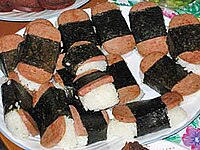Spam musubi: Difference between revisions
→See also: another Hawaiian dish that can involve rice and Spam |
|||
| Line 36: | Line 36: | ||
==References== |
==References== |
||
{{reflist}} |
{{reflist}} |
||
== External links == |
|||
[http://guide.slinky.me/Spam_Musubi Step by Step instruction Spam Musubi] |
|||
[[Category:Hawaiian cuisine]] |
[[Category:Hawaiian cuisine]] |
||
[[Category:Spam dishes]] |
[[Category:Spam dishes]] |
||
Revision as of 15:03, 14 July 2012
 Spam musubi made from Spam and rice | |
| Course | Snack |
|---|---|
| Place of origin | United States |
| Region or state | Hawaii |
| Serving temperature | Hot or cold |
| Main ingredients | Spam, rice, nori |
Spam musubi is a popular snack and lunch food in Hawaii composed a slice of grilled Spam atop of a block of rice, wrapped together with nori dried seaweed in the tradition of Japanese omusubi.
Inexpensive and portable, spam musubi is commonly found near cash registers in convenience stores all over Hawaii.
Preparation
Typical preparation begins with grilling slices of spam, sometimes with a light teriyaki flavor. An acrylic mold (often the shape of a slice of spam) is then placed over a long, narrow piece of nori and rice is pressed into the mold. The grilled spam is placed over the rice before the mold is removed. The nori is then wrapped over the top and around the musubi.
Variants
Spam musubi with furikake and scrambled egg. Musubi may also be with fried shrimp, chicken katsu, or pork cutlet instead of Spam.
History
Spam became a popular food in Hawaii after WWII. Spam was a main course military food for the troops during the war. The large military presence in Hawaii led to spam becoming a popular local food. Local Japanese created the Spam Musubi as result.
See also
- Cuisine of Hawaii
- Loco moco, another Hawaiian dish that can involve rice and Spam
